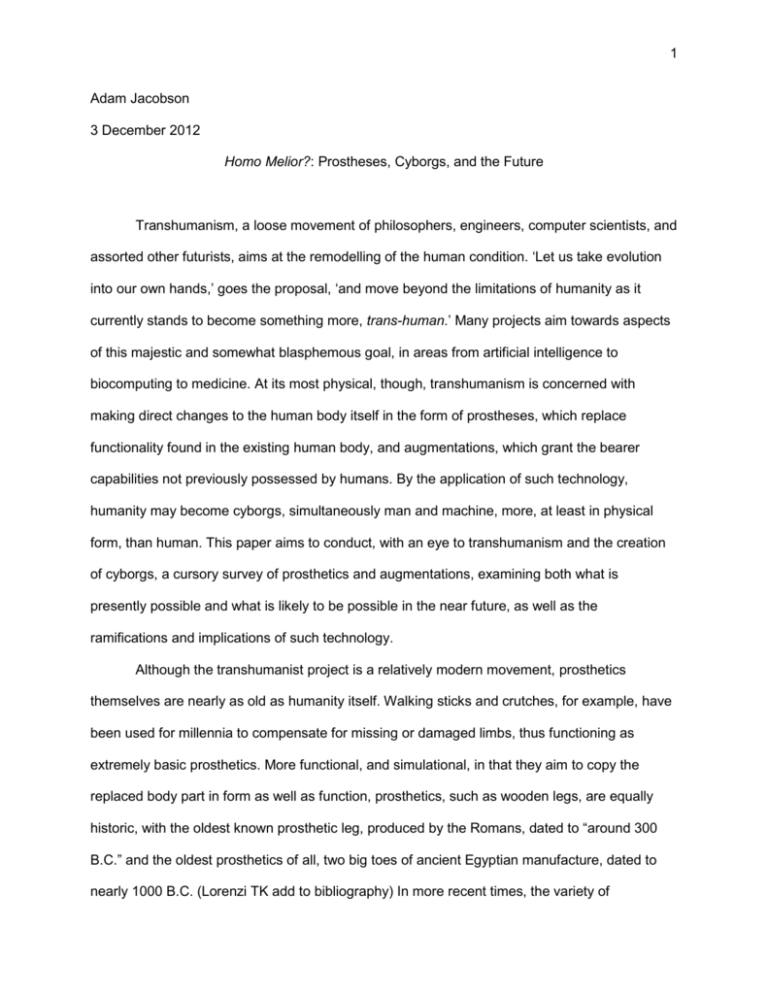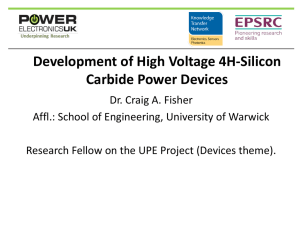Picture
advertisement

1 Adam Jacobson 3 December 2012 Homo Melior?: Prostheses, Cyborgs, and the Future Transhumanism, a loose movement of philosophers, engineers, computer scientists, and assorted other futurists, aims at the remodelling of the human condition. ‘Let us take evolution into our own hands,’ goes the proposal, ‘and move beyond the limitations of humanity as it currently stands to become something more, trans-human.’ Many projects aim towards aspects of this majestic and somewhat blasphemous goal, in areas from artificial intelligence to biocomputing to medicine. At its most physical, though, transhumanism is concerned with making direct changes to the human body itself in the form of prostheses, which replace functionality found in the existing human body, and augmentations, which grant the bearer capabilities not previously possessed by humans. By the application of such technology, humanity may become cyborgs, simultaneously man and machine, more, at least in physical form, than human. This paper aims to conduct, with an eye to transhumanism and the creation of cyborgs, a cursory survey of prosthetics and augmentations, examining both what is presently possible and what is likely to be possible in the near future, as well as the ramifications and implications of such technology. Although the transhumanist project is a relatively modern movement, prosthetics themselves are nearly as old as humanity itself. Walking sticks and crutches, for example, have been used for millennia to compensate for missing or damaged limbs, thus functioning as extremely basic prosthetics. More functional, and simulational, in that they aim to copy the replaced body part in form as well as function, prosthetics, such as wooden legs, are equally historic, with the oldest known prosthetic leg, produced by the Romans, dated to “around 300 B.C.” and the oldest prosthetics of all, two big toes of ancient Egyptian manufacture, dated to nearly 1000 B.C. (Lorenzi TK add to bibliography) In more recent times, the variety of 2 prosthetics available has expanded immensely, with replacements of varying degrees of fidelity to the organic on offer for many an organ. Bones, especially, have been long established as replaceable; the first hip replacements, for example, took place in the “late 1800s,” with successful replacements performed on many other joints in the body over the next century. (Manderson 59) Indeed, the field is so well established that most recent progress has been in merely the composition of the implants themselves, with a steady progression of incrementally improved artificial bones made from “plastic, cobalt, chromium and titanium,” among other materials. (Manderson 59) This relative stagnation has a simple cause: current pure-physical implants (implants that operate purely mechanically, with no electrical or computer components) are operating at or near the peak of present day materials science, able to match the natural structures they aim to replace in many regards. (eg Oscar Pistorius, who runs at the Olympic level on two artificial lower legs made of carbon fiber. [Hilvoorde and Landeweerd 2222]) At present, in addition to the historical prostheses described above, a wide variety of experimental prosthetics exist. These devices, though often speculative and neither rigorously tested nor widely deployed, represent the cutting edge of human augmentation, serving as a snapshot of the height present-day technology. While the field of hearing implants, meant to grant the ability to perceive sound to those with malfunctioning or absent auditory physiology, is long established, progress towards the restoration of sight has been more limited, with, as yet, no commercial products. (Hearing implants have been commercialized and widely available since the mid-80s.) (Rosahl 289) Now, however, artificial vision technology is beginning to bear fruit. Microprocessors, attached to light sensors or cameras and implanted directly into the eye, in contact with nerve cells, have been used to deliver a “train of stimuli…to…the optic nerve, ” providing some measure of sight. (Rosahl 290) Such devices are limited by the need for external power supplies, since it is impossible to fit a power source into the eye along with the interface chip, and offer very limited resolution: “40x40 elements,” presumably equivalent to computer pixels, and a field of view of “about 12 degrees.” (Rosahl 291) The technical 3 specifications are not awe-inspiring, but what matters most is the precedent set: successful integration between a computerized sensory system and a highly complicated set of nerves (each eye contains 130 million photoreceptors [Rosahl 290]), a first step towards direct mindmachine interfaces. In terms of direct mind-machine communication, the experiments of Kevin Warwick offer a fascinating glimpse at the possibilities of present technology. In 2001, he had a tiny microelectrode array “implanted into [his] nervous system via the median nerve in [his] arm” (Warwick caption on page 2 of picture insert), so as to record the neural signals associated with movement of his fingers and miscellaneous sense data sent along the nerve. (Warwick 131-2) The implant worked successfully, and Warwick was able to make a number of highly impressive demonstrations of the technology. By connecting the chip in his arm to a computer programmed to interpret the produced by his nerves when he opened or closed his hand, he made a robotic hand precisely follow his actions, opening and closing with his flesh and blood appendage. (Warwick 233) Using similar ‘translation’ programs, he was also able to control a number of other simple electronic systems, such as a “Lego [sic] robot” (Warwick 235) and a virtual coffee maker (Warwick 234), as well as drive a powered wheelchair. (Warwick 288-9) Critically, though, this implant was not a one-way device, merely reading Warwick’s nerve impulses; it also sent artificial, computer-generated, signals into his nerves. After connecting the implant to force sensors, Warwick was able to “feel the force [of an artificial hand on an object]…on [his] own hand.” (288) After his wife was fitted with a similar implant, she and Warwick were able to send pulses to each other over the Internet, with near-perfect accuracy, performing “the first direct nervous system to nervous system link-up.” (Warwick 282-7) The most tantalizing present-day experiments, though, from a transhumanist perspective, are those that push human sensory perception beyond its present limits and into new fields. To be a cyborg, a trans-human, is to be one “whose capabilities are extended beyond normal limits” (Chris Butlin, quoted on Warwick 61) Thus, as one’s physical abilities expand, as the legs of 4 Oscar Pistorius promise, so too must one’s senses. Warwick achieved results here as well. After a set of ultrasonic antennae were attached to his implant, he acquired a form of echolocation and was able to ‘see’ the distance to nearby objects while blindfolded. (Warwick 262-4) He “had gained a new sense.” (Warwick 264) While this was an impressive demonstration of the brain’s plasticity and ability to process novel sensory data, an important prerequisite for all such future endeavors, for if the brain were limited to interpreting only natural senses the prospects for future augmentation would be rather limited, it essentially merely replicated a specific aspect of sight. The data were sourced and presented to the brain in a novel manner, but they themselves (the knowledge of how far away a certain object was) could have been obtained by any person with functional eyes. Thus, the augmentation described by Norton provides a more powerful demonstration of transhumanist potential: the acquisition, via a simple implant, of a sense possessed by no living human. He, along with several others, had a “rare earth magnet implanted in his finger” and thereby gained the ability to sense electromagnetic fields. (Norton) Interestingly, although the magnet transmits sensation to the implantee via vibrations, the implantee perceives magnetic fields as “tingles” and “pure stimulation.” (Norton) In addition to their transhumanist potential, both these bold experiments, unfortunately, also demonstrate a key drawback of present-day implant technology: the tendency of the implant itself to fail while inside the body. By the end of the experiment, only three of the one hundred contacts between Warwick’s implant and his nerves remained functional (Warwick 256) and Norton’s implanted magnet “shattered into pieces.” (Norton) By extrapolating from the above and general technological trends, it is possible to gain an some idea of what the next few years may bring. For ‘dumb’ prosthetics the current slow pace of advance will likely continue, with incremental advances in engineering and materials leading to incremental, but consistent, improvements in performance. (Manderson 60) Computerized prosthetics, on the other hand, will likely prove much more exciting, their development driven by the powerful advances already taking place in general computing and 5 the integrative work of scientists such Professor Warwick. By tapping the extant nerves and using computers (built into the arm) to process the signals into commands to be sent to motors and provide force-feedback into those same nerves, a prosthetic arm presently in development can achieve a level of functionality almost equal to that of a natural arm. (Williams TK add to bibliography) With time and further research providing better understanding of the nerves involved and better signal processing, it seems not unreasonable to predict that, in the near future, similar computer-aided prosthetics will grant amputees and those born without limbs artificial organs (near-)equal to, or possibly even superior to, organic limbs in power, control, and perception. Critically, it is the application of computer power to what were formerly purely mechanical systems that is leading, and will lead to this great leap in prosthetic technology. A so-called ‘computer revolution’ has already transformed countless sectors of human life, from business to entertainment to air travel; prosthetics are simply the next area of revolution. The truly earthshaking advances, though, will come from using emerging technology to push the capabilities of the human body into realms completely inaccessible to pure humans, those not cybernetically enhanced. The electromagnetic sense that Norton acquired in a backalley procedure will likely be just the first of many such non-standard senses granted by augmentations. In a similar vein to Warwick’s experiments with an ultrasonic ranger (Warwick 262-4), it is simple to imagine connecting a wide variety of sensory equipment, from sensors for any segment of the electromagnetic spectrum, allowing vision beyond the so-called ‘visible range’ of frequencies, to more esoteric devices, such as gravimeters or ammeters, directly to the nervous system. The cyborg of the near future will thus be vastly more aware of the world around themselves than any contemporary human, thanks to their greatly enhanced sensory perception. These augmentations, as well, as the advanced prostheses described above, are all minor examples of what may well be the holy grail of transhuman augmentation: the mindmachine interface, wherein an artificial device is connected directly to the brain itself. Nervecontrolled prostheses and additional senses are only the beginning of what such an interface 6 would allow, such as direct access from the brain to all the general-purpose computational power of any number of silicon chips, allowing for, among other things, intuitive control of complicated mechanical systems. Such fusions have already been performed upon some insect species (Warwick 109), although, given the great complexity of the human brain, it is likely that the equivalents of such interfaces for humans are a long way away. Of course, all these advanced devices will require power, often in copious quantities. While many current prostheses and implants run on internal batteries or external power supplies, these technologies have significant issues. Internal batteries, such as those used in implanted defibrillators and other such devices, inevitably run dry and can only be replaced through surgery, an impractical and invasive solution. (Halperin 13) While external batteries present no such difficulties, their weight and size often cause significant encumbrance. See, for example, the oversized ‘gauntlet’ that Warwick used to power and communicate with his implant. (Warwick picture section) Furthermore, by requiring connections that pierce the skin, so as to supply power to the implant, such external power sources leave the implantee continually vulnerable to infection. (Fessenden 43) Thus, future augmentations are likely to rely on other sources of power than batteries. Since external generators are obviously inferior in this regard, the best solution may be to make the devices power themselves, as a recent development in fuel cell technology promises. Using glucose, which is readily available in the body, as fuel, these new biofuel cells produce a continuous supply of power from within the body, and have already been successfully “integrated” into basic electronic circuitry. (Fessenden 43) While such fuel cells are probably “10 years” away from commercialization, due to insufficient power production and issues with bio-reactivity, implants equipped with improved versions of such fuel cells could function completely autonomously within the body, powering everything from mindmachine interfaces in the spinal column to artificial muscle fibers. (Fessenden 43) While advanced implants and computerized prostheses have great potential and offer huge improvements over traditional, ‘dumb’ prostheses, they also come with additional risks. 7 With a ‘dumb,’ non-computerized prostheses, failure only occurs when the physical structure of the device itself is compromised, eg, a wooden leg breaking under extreme stress, or the hinge on a simple prosthetic arm locking due to insufficient lubrication. While such failures are, clearly, not without risk to the bearer, because they are due to the physical properties of the prosthesis, they are both immediately obvious and easily diagnosable. Most importantly, to deliberately induce such a failure, to maliciously compromise a ‘dumb’ prosthesis, is not easily accomplished without obvious brute force and direct physical access to the prosthesis in question, thus making such attacks generally unproductive and infeasible. Unfortunately, computerized prostheses lack several, if not all of these advantages, rendering their bearers significantly more vulnerable. In an extreme example, Halperin et al., a multidisciplinary team of researchers, managed, with no prior knowledge of the interior workings of the device, to reverse engineer the wireless signals used to control an implantable defibrillator and gain near complete control over the device. (1-2) Critically, they gained the ability to remotely activate the defibrillator, potentially killing the implantee, and to artificially “[deplete] the battery life and [threaten the] availability” of the device, leaving the bearer vulnerable to future incidents requiring defibrillation. (Halperin 2) This attack is performed remotely, via a radio transmitter, though only out to a range of “several centimeters.” (Halperin 2) As this example demonstrates, a computerized implant, capable of communicating with external devices for worthy reasons (such as the ability to “modify [the device’s] setting without surgery” [Halperin 1]), is made vulnerable by those very advantages; a ‘dumb’ defibrillator, for all its disadvantages, could not be so compromised. Most devastatingly, for a security standpoint, this attack can be performed without alerting the implantee, since the sabotage is performed over a wireless connection. While, as Halperin et al. note, no such attack has yet been carried out (2), that it is so easily and subtly performed is quite worrying. When considered in the light of the more thoroughly integrated systems imagined by Professor Warwick, such an attack becomes terrifying. Even as far back as the late 90’s, it was possible to control the body by computer, as shown by the work of an artist known as Stelarc, 8 who used a computer to guide his movements by means of electrodes placed on his skin to stimulate his muscles. (Warwick 70) Even now we can already perform the sort of integration that will render this manner of indirect control obsolete: the construction of a mind-machine interfaces, with computers connected “directly into the brain,” have been built for cockroaches, leeches, and even rats. (Warwick 109) In humans, implants that directly stimulate muscles on command (from either an external source or from other implants that react to specific muscle motion) to, for example, restore the ability to grip to paraplegics, are already in use. (Warwick 117) Computer systems are already fundamentally involved in these implants, and as they grow more complicated and more powerful, as the implants for paraplegics restore the ability not just to generically grip, say, but to grip with individual fingers with specific amounts of force, computers will only become more entangled in the process. From a security standpoint, this is potentially catastrophic, for, the more powerful the system, the more devastating the successful attack. External subversion of muscle control, or even, via hijacking of whatever direct mindmachine interfaces may exist, one’s very thoughts, would be a brutal crime. As the example of the defibrillator demonstrates, every beneficial function can be subverted and put to evil ends; the greater the benefit, the greater the potential evil. The opportunities for crime, for hostage taking and extortion and torture, are incredible, and thus the threat faced is immense. Fortunately, though, the bearers of these future prosthetics will not be completely at the mercy of the world; security is indeed possible, though not without tradeoffs. As Halperin et al. discuss in their paper, wireless attacks such as theirs can be thwarted by several simple modifications to the implant. The implant can be made to “audibly alert” (Halperin 10) the patient when an attempt is made to communicate with the device, allowing the implantee to notice and respond to attacks. Additionally, a “cryptographically strong [communication] protocol” (Halperin 10) can be used, preventing an adversary from easily reverse engineering the codes needed to sabotage the implant. Unfortunately, such security measures cannot be made arbitrarily strong, as they must not “hinder treatment in an emergency situation” or otherwise prevent the device 9 from functioning properly. (Halperin 10) Also, while such relatively passive measures as these may (‘may’ is the operative word here, as Halperin notes that very little research has been done in this area [10-11]) be sufficient to protect such a relatively simple implant as the defibrillator under discussion, it seems clear, from the history of computer systems thus far, that as implants advance in complexity, the security measures necessary to provide even nominal protection will increase dramatically. By analogy to general computer history, an ‘arms race,’ a constant evolutionary battle of adaptation and counter-adaptation between security programs and threats, seems likely. However, prosthetics and augmentations complex enough to require such complex security procedures are likely many years away from widespread availability and use (see above) and so it is hard to speculate beyond these generalities. In addition to the practical issues of safety and security discussed above, the advance of implant technology also raises new ethical considerations. Historically, prosthetics have been firmly placed in the realm of the disabled. Their purpose was to provide (some semblance of) normal bodily functionality to those whose bodies were lacking in some regard. The prosthesis served to simulate some aspect of the healthy and whole body, to undo some physiological compromise. Most importantly for the following discussion, this placement has meant that the unaugmented human, an average person with no disabilities, was always superior in ability to the average prosthesis-endowed human, for prostheses were inferior in ability to that which they attempted to replace. Put simply, a prosthetic heart, for all its life-saving power, is strictly inferior to the natural article, and so on for other organs. In the present day, though, we appear to have come to an inflection point; prosthetics are beginning to equal, and possibly surpass, natural organs. Indicative of this change is the runner Oscar Pistorius, who, despite running on two artificial lower legs, is firmly competitive with “elite [Olympic-level] athletes on ‘natural legs.’” (Hilvoorde and Landeweerd 2222) As Hilvoorde and Landeweerd discuss, this toppling of the previous hierarchy of natural over prosthetic (while Pistorius is ‘merely’ competitive with and not strictly superior to his unaugmented competitors, he is easily seen as a harbinger of what further 10 technological advances will bring) “blur[s] the distinction between able and disabled” (2224) and, ironically, may even invert it. When prosthetics are superior to flesh and bone, a new, “increased inequality” will arise, “between those that are technologically ‘enhanced’ and those that are not.” (Hilvoorde and Landeweerd 2224) Those formerly regarded as ‘abled’ will take the place of the ‘disabled,’ as the augmented, formerly ‘disabled’ and otherwise, tower above them in capability. While this raises obvious issues around the concept of ‘fair competition’ in sports (Hilvoorde and Landeweerd 2223-6), this is a matter of grave concern for ethics in general, for it has the potential to increase social stratification along socioeconomic lines. Key to John Rawls’ conception of ‘justice’ is the notion that, all personal capabilities being equal, two individuals should have equal opportunity, regardless of the circumstances of their birth and family. In general, this is the Western framework used to evaluate items effecting societal outcomes; that which is good is that which promotes Rawlsian justice. (Hilvoorde and Landeweerd 2223) Since advanced prosthetics are, as high tech works of specialized engineering, expensive items, the inability of the economic lower class to afford enhancements easily available to the upper class will suppress them even further and increase the anti-Rawlsian inequality of outcomes between rich and poor. Warwick takes this prophecy of widening to the extreme, arguing that “cyborgs will split from humans. Those who remain as mere humans…[will] become a sub-species…the chimpanzees of the future.” (4) Given that human domination over less able animals is marked by “contempt” and the often callous “disposal” of lives (Warwick 2), such a scenario does not bode well for the unaugmented, and should give pause to transhumanists. Even if all of humanity will eventually be so augmented, and equality thus regained on a higher plane of ability, unless the transition is literally instantaneous, provisions will need to be made to protect those who, due to choice or contingency, remain fully natural in an augmenting society. It would be a deeply ironic disaster if transhumanism, in bootstrapping humanity past the stifling confines of the flesh, only deepened the devastating inequalities of the present world. 11 The transhumanist project, as mentioned above, is at an inflection point. Technology formerly only dreamt of is now making its way from the brains of futurists into the research labs and factories of the world, soon to spread to wide availability. From carbon-fiber legs to hardwired nerve interfaces, the possibilities for human expansion grow almost daily. Cyborgs, some argue, already walk among us, as our omnipresent computer devices function as mental augmentations, prosthetic brains; soon, however, this will unarguably be the case, as implants and replacement organs become more common and, eventually, commoditized. All this, however, is not set in stone, and herein lies the choice to be made. How will this brave new world of implants be regulated and governed? Will this technology be available to all, subsidized or on loan, or restricted only to the military and/or the rich? How will humanity (or will it, even) act to prevent a Brave New World, in which modification of the human body becomes the means to tyranny and oppression? Finally what does this project mean for ‘humanity’ itself? How much augmentation turns a human into a transhuman? Whatever choices and discoveries are made, however these questions are answered, may the transhumans of the future look kindly upon us, we who lived in this era of their birth. 12 Works Cited: Fessenden, Marissa. "Sugar-Powered Pacemakers." Scientific American December 2012: 43. Halperin, Daniel et al. “Pacemakers and Implantable Cardiac Defibrillators: Software Radio Attacks and Zero-Power Defenses.” IEEE Symposium on Security and Privacy, May 2008. Medical Device Security Center. Web. 25 Nov. 2012. http://www.secure-medicine.org/icdstudy/icd-study.pdf Lorenzi, Rossella. “Ancient Egyptian Fake Toes Earliest Prosthetics.” Discovery News 2 Oct. 2012: n.pag. news.discovery.com. Web. 14 Dec. 2012. http://news.discovery.com/history/ancient-egypt-wooden-toes-prosthetics-121002.html Manderson, Lenore. Surface Tensions: Surgery, Bodily Boundaries, and the Social Self. Walnut Creek: Left Coast Press, 2011. Norton, Quinn. "A Sixth Sense for a Wired World." Wired 7 June 2006: n.pag. Wired.com. Web. 25 Nov. 2012. http://www.wired.com/gadgets/mods/news/2006/06/71087?currentPage=all Rosahl, Steffen K. "Vanishing Senses—Restoration Of Sensory Functions By Electronic Implants." Poiesis & Praxis 2.4 (2004): 285-295. Academic Search Premier. Web. 25 Nov. 2012. Van Hilvoorde, Ivo, and Laurens Landeweerd. "Enhancing Disabilities: Transhumanism Under The Veil Of Inclusion?." Disability & Rehabilitation 32.26 (2010): 2222-2227. Academic Search Premier. Web. 25 Nov. 2012. 13 Warwick, Kevin. I, Cyborg. London: Century, 2002 Williams, Adams. “Mind-controlled permanently-attached prosthetic arm could revolutionize prosthetics.” Gizmag 29 Nov. 2012: n.pag. Gizmag.com. Web. 14 Dec. 2012. http://www.gizmag.com/thought-controlled-prosthetic-arm/25216/








